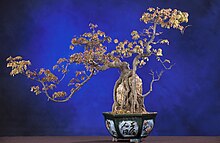Penzai
| Penjing | |||||||||||||||

Penjing in root-over-rock style on display at the Chinese Penjing Collection of the National Bonsai and Penjing Museum in Washington, D.C.
|
|||||||||||||||
| Chinese | 盆景 | ||||||||||||||
|---|---|---|---|---|---|---|---|---|---|---|---|---|---|---|---|
| Literal meaning | tray scenery | ||||||||||||||
|
|||||||||||||||
| Alternative Chinese name | |||||||||||||||
| Chinese | 盆栽 | ||||||||||||||
| Literal meaning | tray plant | ||||||||||||||
|
|||||||||||||||
| Transcriptions | |
|---|---|
| Standard Mandarin | |
| Hanyu Pinyin | pénjǐng |
| Yue: Cantonese | |
| Jyutping | pun4ging2 |
| Southern Min | |
| Hokkien POJ | phûn-kéng |
| Transcriptions | |
|---|---|
| Standard Mandarin | |
| Hanyu Pinyin | pénzāi |
| Yue: Cantonese | |
| Jyutping | pun4zoi1 |
| Southern Min | |
| Hokkien POJ | phûn-chai |
Penjing (Chinese: 盆景; pinyin: pénjǐng; literally: "tray scenery"), also known as penzai (Chinese: 盆栽; pinyin: pénzāi; literally: "tray plant"), tray landscape, potted scenery, potted landscape, or miniature trees and rockery, is the ancient Chinese art of depicting artistically formed trees, other plants, and landscapes in miniature.
Penjing generally fall into one of three categories:
Similar practices exist in other cultures, including the Japanese traditions of bonsai and saikei, as well as the miniature living landscapes of Vietnamese hòn non bộ. Generally speaking, tree penjing specimens differ from bonsai by allowing a wider range of tree shapes (more "wild-looking") and by planting them in bright-colored and creatively shaped pots. In contrast, bonsai are more simplified in shape (more "refined" in appearance) with larger-in-proportion trunks, and are planted in unobtrusive, low-sided containers with simple lines and muted colors.
While saikei depicts living landscapes in containers, like water and land penjing, it does not use miniatures to decorate the living landscape. Hòn non bộ focuses on depicting landscapes of islands and mountains, usually in contact with water, and decorated with live trees and other plants. Like water and land penjing, hòn non bộ specimens can feature miniature figures, vehicles, and structures. Distinctions among these traditional forms have been blurred by some practitioners outside of Asia, as enthusiasts explore the potential of local plant and pot materials without strict adherence to traditional styling and display guidelines.
Classical Chinese gardens often contain arrangements of miniature trees and rockeries known as penjing. These creations of carefully pruned trees and rocks are small-scale renditions of natural landscapes. They are often referred to as living sculptures or as three-dimensional poetry. Their artistic composition captures the spirit of nature and distinguishes them from ordinary potted plants.
...
Wikipedia
